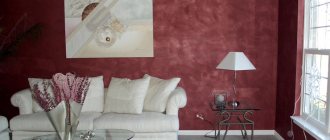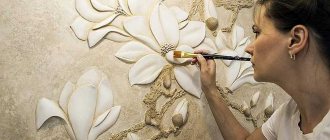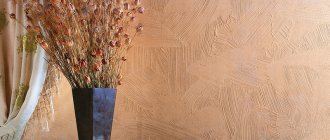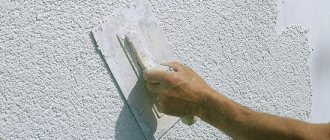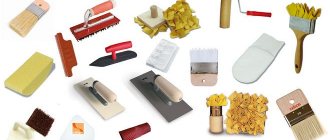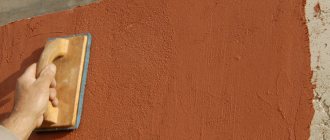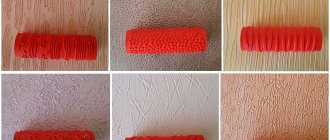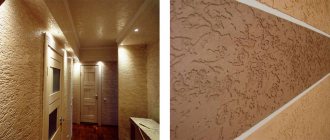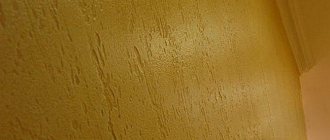What is decorative plaster
Decorative plaster is a finishing material used for finishing coating of vertical and horizontal surfaces indoors and outdoors. These mixtures allow you to create unique designs, colored patterns with curly textures and textures. Due to the properties of the composition, it is possible to make an imitation of tree bark, sandstone, marble, gabbro, and crocodile skin.
When finished, the mixture resembles medium-fat sour cream with inclusions of small stones, and the color may vary depending on the type of plaster. This decor has the following advantages:
- compressive strength more than 5 MPa;
- possibility of application on a deformed base;
- resistance to temperature changes;
- moisture resistance;
- high vapor permeability;
- unique design look;
- ease of application.
Mixtures of this type appeared on the Russian market not so long ago, but have already managed to arouse the interest of buyers.
Differences between decorative and ordinary plaster
For an inexperienced person, interior plaster is no different from ordinary plaster. But in fact, they differ radically due to several factors:
| Regular | Decorative | |
| Application | It is used to level walls and ceilings, and can be applied in a layer of up to 5 cm in one pass. | It is used to create the interior of rooms, with a maximum layer of up to 5 mm. |
| Compound | Includes a binder, coarse filler, for example, sand with a fraction of up to 1.25 mm and plasticizers that make application soft. | It consists of a fine fraction of binder and filler with the inclusion of natural stone with a particle size of up to 4 mm to create texture. |
| Application | It is thrown in two ways - mechanized or by hand. In this case, the rule and spatulas of different widths are used. | It is carefully smoothed only by hand using more tools, which may vary depending on the type of plaster. |
If you look at the physical properties of mixtures, they are often similar.
When purchasing material, you need to mention that you are interested in decorative plaster, so as not to mislead the seller.
What does the finishing material consist of?
As a base, the same components are used as in the production of conventional plaster solutions. In particular:
- Lime.
- Cement.
- Gypsum.
Gypsum-based plasters are found and used extremely rarely. This is due to the fact that the prepared solution has a relatively low viability and hardens quickly after preparation.
The mixture is transferred to the category of decorative plasters by fillers included in the composition by the manufacturer. These components change the color, texture and texture of the applied plaster.
Plasticizing additives and artificial dyes, acrylic resin, wood or synthetic fiber, and fine particles of natural stone can be used here. Depending on the fillers, the composition can be monochromatic or multi-colored.
Types of decorative plaster in the interior
Based on their various properties, decorative mixtures are classified according to two criteria:
- by binder;
- according to the texture of the coating.
Based on the first feature, the following types are distinguished:
- Mineral plaster is a dry construction mixture made from white or gray cement, lime, less often gypsum and sand aggregate. Often requires mixing in water to work. It is characterized by high strength, vapor permeability and versatility of use. Apply to smooth concrete, plastered surfaces or brick.
- Acrylic - ready-mixed. It stands out for its average price, the possibility of tinting, moisture resistance, and good adhesion to mineral and wooden substrates. To increase bending strength and better hiding power, latex is sometimes added.
- Silicone – ready-made composition based on silicone. It applies well to any substrate, can be tinted in different colors, breathes well, and can withstand humidity conditions of more than 60%.
- Silicate - a ready-made mixture of potassium glass. Used for finishing facades.
Silicate mixtures consist of caustic alkalis, and therefore require special gloves with a respirator and protection of mucous tissues.
The main characteristics of the compositions are presented in the table.
| Characteristic | Mineral | Acrylic | Silicone | Silicate |
| Price | low | average | high | high |
| Vapor permeability | average | low | average | high |
| Moisture resistance | average | average | high | high |
| Abrasion | high | average | low | low |
| Life time | up to 25 years | Over 25 years | up to 50 years | up to 50 years |
According to the pattern, the mixtures are divided:
- Textured - ready-made or dry solutions intended for interior work, characterized by increased plasticity. Textured plaster for interior wall decoration allows you to create different designs, for example, panels or bas-relief.
- Structural - mixtures are similar to textured ones, but include a special crumb that creates the desired pattern during application. A common type of plaster that creates fur coat, bark beetle or lamb patterns.
- Venetian is a type of artistic plaster created from a combination of several solutions (gypsum, lime, marble chips). Apply in several layers. Each new finished surface will be different from the previous one. Requires certain skills and a creative approach from the master. Creates fabric surfaces such as gray silk, stone concrete or imitation natural stone.
- Stone chips are a finishing material called mosaic. It consists of stone chips of large or small fractions, glued to the surface with a special polymer.
- Flocking is a modern type of decor that resembles shards of smooth colored glass glued to the wall. Can create scaly skin and velor effects.
- Solutions that create the effect of an orange peel are used more often in light colors in combination with other types of decor.
Popular textures
Thanks to fillers, you can create quite interesting textures. The most popular types of design include:
Graffito
A very original composition that accurately imitates natural stone. The solution is applied with a special gun and can be used for interior and exterior work. The material is relatively inexpensive, and the finishing can be done on your own.
Under concrete
An interesting option for finishing interior spaces with an exact imitation of a monolithic concrete surface. The composition contains grains of sand and pebbles, which begin to shimmer when exposed to sunlight. The solution is applied in layers, which allows you to achieve the effect of a three-dimensional surface. The plaster is available in ready-made form and has various shades.
Wet silk
After application and drying, the composition resembles fabric that shimmers in the sun. There are several tinting options, however, in any case, the wall looks like flowing silk. The material is not afraid of a humid environment, so it is often used for finishing bathrooms and kitchens.
Roller room
The composition includes natural fine filler. As a result, after application, a relief surface with intricate patterns is obtained. Additional tinting and surface painting are allowed for this plaster.
Latex plastic
After application, a smooth coating with a glossy surface is formed on the wall. The texture exactly replicates processed natural stone or marble. After drying, the solution becomes highly resistant to any external influences and is not afraid of moisture.
Under the brick
It imitates brickwork, and after plastering it provides almost unlimited space for the interior. Gone are the days when a simple brick wall was considered a symbol of poverty. Now it is a sign of taste and originality.
Terrasite
According to reviews, this is one of the most beautiful types of decorative plasters available on the market. The solution contains stone chips and quartz sand. After application, the wall is decorated “antique”, giving off the spirit of sophistication and aristocracy.
Travertine
This plaster accurately copies the natural stone of the same name. The solution is easy to apply and allows you to create any kind of design for interior decoration. The composition includes marble chips, acrylic resin, lime. After application, the plaster perfectly levels out visual defects of the wall.
Kameshkovaya
A fairly common option for finishing the interior of residential and commercial real estate. The composition includes calibrated small stones.
The individual components are bonded together by polymer-based substances. In addition to its presentable appearance, such plaster serves as an additional layer of thermal insulation.
Under the sand
Creates an accurate imitation of a sandy surface. Particles of quartz sand shimmer beautifully in the sun. To enhance the effect, some manufacturers add mica and shells to the composition. After applying the solution, a smooth wall with a glossy or matte surface is formed.
Mramorino
A good option for finishing interior spaces in an antique style in Italian style. Plaster allows you to hide minor defects in the base, allowing you to save on preparatory work. The composition includes polymer resins, which provide high stability of the solution to a humid environment.
Where is decorative plaster suitable?
The use of decorative relief plaster emphasizes the wealth of the apartment’s residents, so the finishing material is not suitable for minimalism. The most common styles where interior mixtures can be used are:
- High-tech dictates the simplicity of the room, so cladding with bark beetle, small lamb, orange peel, and mosaic is suitable for wall decoration.
- Avant-garde is a modern, rich style. When filling your interior with it, you need to use the most fashionable materials, for example, flock or Venetian.
- Classic - the interior shows an abundance of natural materials and fabrics. In this case, it is better to use a fabric effect or a beautiful texture.
Selection of decorative plaster
The beautiful decor of the room and the durability of the walls completely depend on decorative plaster for interior wall decoration. Therefore, there are several criteria by which a suitable building composition is determined:
- room humidity level;
- the material from which the walls are made;
- successful combination of shades;
- required vapor permeability;
- vibrations of the base.
At the same time, if the room has freezing walls, it is better to choose frost-resistant materials.
general information
What you need to look at first:
- what is the base for applying the coating, is the selected plaster suitable for it;
- the difficulty of creating a decorative effect. Often the result of the work does not coincide with the beautiful examples of the manufacturer due to the lack of experience of the performer. It is worth first assessing the complexity of the application technology before purchasing a specific mixture;
- additional costs associated with preparation of the base, finishing coating, use of auxiliary materials and tools. Sometimes they are higher than the cost of plaster.
Criterias of choice
| Comparison criterion | Characteristics | Explanations |
| By degree of readiness | dry | In the form of a dry mixture.
|
| ready | In the form of a ready-made solution.
| |
| By type of binder | mineral | Based on cement, a mixture of cement with lime or sand, or gypsum. For application to mineral substrates inside and outside buildings, supplied in the form of dry mixtures. |
| acrylic | Supplied as a ready-made water-dispersion mixture. Apply to all types of substrates that absorb water. In terms of vapor permeability, it is inferior to plasters with mineral binders. For exterior and interior decoration. | |
| silicate | Liquid glass is used as a binder. Applicable to mineral and silicate substrates. It is characterized by high vapor permeability and moisture resistance, a poor color range compared to polymer mixtures and a higher cost. Suitable for exterior decoration. | |
| silicone | On silicone resins for all types of substrates inside and outside buildings. The finished coating is durable, has water-repellent properties with high vapor permeability. The disadvantage is the high cost - more expensive than other options. | |
| By the nature of the coating | smooth | Ready-made mixtures filled with fine marble powder are used. The material is applied in several layers, the coating is thin-layered, and can even be used when finishing a gypsum plasterboard ceiling. The result is ensured by careful grinding. Characteristic of Venetian plasters. |
| rough | Without grinding or using mixtures with pronounced graininess. The result is a mosaic covering, fur coat, antique finish, Mediterranean style, etc. | |
| grooved | It is achieved due to the content of mineral filler of different fractions in the mixture. The furrows are created by shearing the larger particle size filler. The result is the bark beetle effect. The coating can be painted in any color. | |
| modeling | Plastic plaster for forming a three-dimensional pattern: from simple repeating stencil patterns to bas-relief. May contain reinforcing fibers to create thick-layer coatings. See popular application options here. |
In fact, the whole choice comes down to assessing the visual component of the texture and the cost of the finishing result. In this article, we have identified popular manufacturers and described mixtures for obtaining various decorative effects.
Please note that the cost of finishing 1 m² of surface indicated in the text does not include the cost of work, as well as the cost of soil and glazing compounds.
Summary table of the most famous manufacturers of decorative plasters
| Manufacturer | Range | Difficulty in creating a decorative effect* | Price segment** |
| 1. Ceresit (Germany) | 14 pcs. with the effects of fur coat, mosaic, bark beetle. | low | average |
| 2. Knauf (Germany) | 4 things. with fur coat and bark beetle effects. | low | average |
| 3. VGT (Russia) | 16 pcs. with effects from bark beetle to Venetian plaster. | average | average |
| 4. Bolars (Russia) | 12 pcs. with the effects of mosaic, pebble covering, bark beetle. | low | average |
| 5. San Marco (Italy) | 30 pcs. with the effects of Venetian plaster, aged, metallized and loft-like coatings. | high | premium |
| 6. Parade (Russia) | 11 pcs. with the effects of bark beetle and fur coat, aged coating, crinkled and smooth silk. | low | average |
| 7. Bayramix (Russia) | 22 pcs. with the effects of marble mosaic, fur coat, bark beetle, simulated coatings. | low | average |
| 8. Optimist (Russia) | 40 pcs. with the effects of sand, mosaic, modeled coatings, Venetian plaster, travertine, wet silk. | high | premium |
| 9. Dufa (Germany) | 18 pcs. with the effects of Venetian plaster, silk, aged coating, fresco, adobe, travertine. | high | average |
| 10. Bolix (Poland) | 24 pcs. with the effects of fur coat, mosaic, natural stone. | low | premium |
| 11. Derufa (Germany, Russia) | 30 pcs. with the effects of silk, Moroccan plaster, simulated coatings. | high | premium |
*Evaluative comparison criterion. It is tied to the required qualifications of the finisher, subject to the use of mixtures from the specified manufacturer.
** The average cost of finishing 1 m² of base was compared.
Features of the decorative finishing process
At first glance, working with these building compounds is easy, because they are sold ready for use. But in reality there are many subtleties.
Tools for getting the job done
Before performing work, you need to prepare the following tools:
- maklovitsa;
- metal spatula 5-10 cm and 20-40 cm wide;
- for mosaic, rectangular spatula;
- for lamb, bark beetle, foam spatula-stroker;
- 2 containers 12 l;
- drill with mixer or trowel attachment;
- work gloves.
Preparing the walls
For high-quality application of interior plaster, the surface must be perfectly flat. If the start has differences after drying, then it must be leveled with the finish.
At the next stage, the surface is wiped from dust. An adhesive primer, called primer-paint, is applied to it. In this case, for mineral and acrylic compositions, a primer based on acrylate or a universal polymer is used, and for silicate and silicone compositions, a primer based on silicone is used.
The emulsion must dry within 6 hours. It is better to carry out the work before going to bed, so that the next day you can confidently begin another stage of work.
It is prohibited to use a regular primer without quartz sand, because it does not properly equalize the water absorption of the base and will not create the necessary conditions for the adhesion of the next layer.
Execution of work
Before starting work with mineral mixtures, you need to mix them with water. To do this, a regulated amount of water is poured into the container. Usually this is 4-5 liters per 25 kg of mixture, depending on the manufacturer. After this, the dry composition from the bag is poured. Mix with a mixer for 5 minutes. When the mixture takes on a homogeneous appearance, it is set aside for 6-7 minutes. Next, you need to mix it again. Violation of this process leads to the fact that not all plasticizers dissolve. As a result, the plaster will not achieve its characteristics.
The prepared solutions are mixed in a bucket for 5 minutes. This is necessary so that the stone that settles to the bottom is evenly distributed throughout the substance.
When the solution is ready, place a small spatula in your left hand and a large one in your right hand. Take a small volume of mass and apply it to a long one. Using the second tool, the mixture is stretched along the wall. This operation is repeated until the entire surface is covered. In this case, the decor should be applied in an even layer without any blemishes.
After 30 minutes the solution begins to set. At this moment you need to take a grater in your working hand. Using a tool with light pressure, circular movements are made over the entire area. The worker should feel the stone rolling under the spatula.
The result is decor or lamb.
Before starting work, you need to calculate the working area. From a bag you can wipe from 6 to 12 square meters. m. depending on the grain size. In addition, the mineral solution begins to harden in the bucket after 1 hour. This must be taken into account to prevent overspending.
Plasters such as textured, structural, stone chips are applied in a similar way with minor differences. Only Venetian plaster and flock stand out. Working with them is individual for each master. It is not recommended for an inexperienced person to do this.
Applying plaster to the wall
How to make decorative plaster with your own hands? For independent implementation by a person without experience, we can recommend a bark beetle type coating. It does not require careful preparatory measures. Due to its texture, there is no need to carefully level it during the application process. To work with such material, a few spatulas of different widths and a little skill in plastering are enough. It is almost impossible to spoil the bark beetle. The technology involves manufacturing in various versions, which directly depends on the size of the inclusion grains. Larger ones will require a thicker layer of coating.
The construction of a “Venetian” is impossible without solid mastery of skills. When performing it, you need to apply several perfectly even layers of plaster, each with its own properties, to a perfectly prepared surface.
Silicone materials also require special skills. This is a painstaking, delicate work that requires incredible patience and artistic inclinations. But the result corresponds to the invested work.
Decoration can be applied to the wall in the following order:
- In accordance with the instructions on the packaging of the mixture, a solution of the required consistency is prepared. Its quantity should provide for the possibility of production at a time. Additional stirring with the addition of water is not possible - the thickened residue will have to be thrown away.
- A spatula and a grater become universal tools. The applied layer of plaster is evenly distributed over the surface. As soon as the mass shows the first signs of hardening, it needs to be rubbed with a grater, at the same time creating a pattern.
- For beginners in this business, there are several simple techniques that allow you to achieve a beautiful decorative design with simple operations. This can be grouting with wavy movements, beveled or straight lines imitating rain, various closed curves or intersecting stripes. Movements when performing work must be confident, soft, and not subject to correction.
- An interesting surface texture can be obtained by using the most unexpected objects, from crumpled paper to brushes or washcloths. The simplest way is to use textured rollers with various patterns. Given the limited drying time of the plaster, drawings also need to be done as quickly as possible; there will be no opportunity for correction.
- 15 - 20 minutes after applying the pattern, the coating begins to lose its shine, which indicates that crystallization of the solution has begun. You need to not miss this moment and walk over the surface with a wet trowel, smoothing out unevenness and removing too sharp changes in the relief. The instrument needs to be cleaned and moistened generously more often.
- To separate sections of coating with different textures, it is advisable to use construction tape. It must be removed before the applied solution hardens to ensure a clean, tear-free interface.
- The solution dries completely within 24 hours. After this time, you need to treat the surface with fine sandpaper. In this way, excessively protruding parts and uneven surfaces are removed.
- A protective coating in the form of varnish or wax is applied to the surface approximately three days after the installation of the decorative layer. Before applying it, you need to thoroughly clean the surface of dust using a vacuum cleaner.
See also: Plasterboard partitions
- When finishing external walls, a concrete surface using river pebbles is popular. After applying the composition to the wall, when it shows the first signs of hardening, you need to wash off a small part of the outer layer of the solution with a wet paint brush. The exposed pebbles make an excellent decorative wall decoration.
Do I need to paint?
Ready-made plasters are tinted in advance and do not require additional painting. This may be necessary for cement mixtures. It is almost impossible to tint them in volume. This results in a different shade on the wall with each painting.
For better protection and increased service life, manufacturers recommend painting mineral plaster 2-3 days after work. For this purpose, use any paint suitable for mineral bases. If the room is not damp, then you can paint it with non-washable paint with abrasion class 3. In kitchens, bathrooms and balconies, humidity exceeds 60%, so washable paintwork with class 1 is used.
VGT (VGT)
The Russian company VGT has been producing paints and varnishes and plaster compositions for decorative finishing since 1992.
The latter are represented by the Gallery line, which includes 16 thin-layer and textured plasters, as well as decorative paints and tools for working with all of the above. By combining these materials, you can get both truly unique and standard textures: bark beetle, Venetian plaster, wet silk, pebble, etc. Characteristics of VGT decorative plasters
| Characteristics | Gallery “Wet silk” | Gallery "Venetian" | Gallery “Colored plaster” |
| Application area | Thin-layer decorative plaster for interior work. The required texture is created in 2 layers. Apply to concrete, brick, plastered surfaces and gypsum plasterboard structures. Available in 5 base colors, the white base is tinted by hand. The finish is suitable for rooms with high humidity, the coating is wash-resistant. | Fine plaster for creating multi-layer coatings. It is applied to an exceptionally flat base: stone or plastered, made of gypsum plasterboard and fiberboard. For interior work: finishing walls and other interior elements. The base composition can be tinted in bulk, using, among other things, highly concentrated colors. | Granular plaster based on marble chips and acrylic binder. For application on mineral surfaces, for interior and exterior use. Available in 7 colors. The finished surface is resistant to wet cleaning and has high hardness. |
| Decorative effect | Iridescent silk. | Imitation marble. | Colored marble chips (grain size 1-1.5 mm). |
| Delivery option | Ready mixture. | ||
| Packing | Bucket 1 or 6 kg. | Bucket 8 or 16 kg. | Bucket 18 or 50 kg. |
| Compound | Water, styrene-acrylic copolymer, modifying additives, filler, pearlescent pigment. | Water, polymer, filler, modifying additives. | Water, polymer, modifying additives, mineral filler. |
| Consumption, kg/m² | 0,15-0,3 | 0,25-0,4 | 5-6 |
| Price, rub./kg. | 640 | 124 | 98 |
| Cost of 1 m² of coverage, rub. | 96-192 | 31-50 | 490-588 |
Impressions from use. Some customers complained about peeling of applied coatings, not only outside, but also inside the building. When analyzing the situations, it turned out that in order to achieve the best effect when preparing the base, it is necessary to use a primer from the same manufacturer, without deviating one step from the manufacturer’s recommendations. VGT is in demand due to its comparatively low price; the product has established itself as a budget option. Most of the positive reviews are justified precisely by the price and wide range, which is very important in these difficult times.
Video about VGT “Wet Silk” and its application:
San Marco (San Marco)
If you are looking for thin-layer decorative plaster from the premium segment, then it should be products under the San Marco TM.
The company's mixtures are sold all over the world. These are Italian-made materials whose history begins in 1937. At the time of writing the review, the range included 30 types of decorative materials to create 50 textures. Add in over 1,500 color options and the finishing options are endless. The company's catalog presents decorative mixtures, bases and protective agents for decorative coatings. Preference is given to highly artistic thin-layer materials for interior and exterior decoration. We recommend visiting the official website using the link below! Characteristics of San Marco decorative plasters
| Characteristics | STUCCO VENEZIANO | MARMORINO CLASSICO | CONCRET_ART |
| Application area | For application to prepared mineral, plasterboard and wooden substrates indoors. The finishing layer does not require wax protection. The base is white, tinted using the Marcromie system. Apply two base coats and one finishing coat. Suitable for use in rooms with high humidity. | A mixture based on mineral binders for the exterior and interior finishing of prepared plastered or painted substrates that do not crumble but absorb water. Fraction size – up to 0.7 mm. The number of layers applied is at least 2. Can be tinted according to the catalogue, the base color is white. | To create a decorative layer with the strength characteristics characteristic of cement. Suitable for all types of prepared substrates. Used for interior and exterior work. Number of layers – 1-2. The finished coating is resistant to frequent wet cleaning, as well as atmospheric influences. |
| Decorative effect | Imitation marble. | Imitation marble, velvety marble, “pepper and salt”, brush marks. | Aged concrete, formwork, washed surface, fine or medium sanding, plaster effect, fine-mesh surface. |
| Delivery option | Ready mixture. | ||
| Packing | Bucket 1, 5, 25 kg. | Bucket 1.25 kg. | |
| Compound | Water, modified acrylic copolymer, filler. | Water, air lime, mineral filler, modifying additives. | Water, acrylic copolymer with siloxane modification, filler, additives. |
| Consumption, kg/m² | 1,4-2 | 2,5-3 | 0,8-1,3 |
| Price, rub./kg. | 753 | 449 | 543 |
| Cost of 1 m² of coverage, rub. | 1054-1506 | 1123-1347 | 434-706 |
Impressions from use. A large selection and decent quality at a high price - this is how you can briefly describe the impressions of using plasters from this manufacturer. Cost is the only negative component. You also need to take into account that in order to obtain a decorative effect, you will have to strictly adhere to the manufacturer’s recommendations and use auxiliary materials from San Marco, which affects the overall cost of finishing. However, you can save on the services of specialists - there are a large number of master classes in the form of video lessons on the Internet.
Video about STUCCO VENEZIANO and its application:
Bolix
The Bolix trademark belongs to a Polish manufacturer specializing in the production of plaster mixtures.
On the market since 1991. Production on modern automated lines from raw materials from BASF and BAYER concerns. The range includes silicone, silicate, silicone-acrylic, acrylic, mosaic and mineral plasters. There are 24 solutions in total, most of which are presented in the form of ready-to-use mixtures for exterior and interior use. Characteristics of Bolix decorative plasters
| Characteristics | TM (0.5-1mm) | DECO (0.5-1 mm) | MP KA15 |
| Application area | For application to prepared mineral substrates inside and outside buildings. The granulation of crumbs in the plaster varies from 0.5 to 2 mm. Apply in 1 or several layers. Due to its resistance to mechanical stress, it is recommended for use in rooms with high throughput. Can be tinted according to the catalog - 40 options. | Apply manually or by spraying in 1-2 layers onto prepared mineral substrates. The maximum layer thickness is 4 mm. The grain size of the filler can be selected in the range of 0.5-2 mm. For interior and exterior decoration. Tinting according to the catalog - 12 colors. The coating is resistant to damage and is recommended for finishing corridors and facades. | To create decorative and protective coatings inside and outside buildings. Mineral plaster for stone bases. Apply in 1 layer. The result of the work is a wear-resistant and moisture-resistant surface, which can be simply restored if necessary. Available colors of the original dry mixture: white and gray. Finished coating for painting. |
| Decorative effect | Mosaic covering. | A natural stone. | Fur coat. |
| Delivery option | Ready mixture. | Dry mixture for mixing. | |
| Packing | Bucket 30 kg. | Bucket 15 or 30 kg. | Bag 25 kg. |
| Compound | Water, acrylic polymer, mineral filler with a grain size of 0.5-1, 1-1.5 or 1.5-2 mm, modifying additives. | Water, acrylic polymer, mineral filler with a grain size of 0.5-1 or 0.5-2 mm, additives. | Polymers, hydraulic binders, mineral fillers, modifying additives. |
| Consumption, kg/m² | 2-3 | 2,8-3,5 | |
| Price, rub./kg. | 259 | 446 | 51 |
| Cost of 1 m² of coverage, rub. | 518-777 | 1249-1561 | 143-179 |
Impressions from use. Compared to analogues, the price is clearly high. The manufacturer offers simple solutions that provide a high probability of finishing success even for beginners. Everything is explained by the poor choice of textures, mainly mosaic type, as well as fur coats and bark beetles. The manufacturer does not offer highly artistic solutions when using decorative plaster, so such materials are more suitable for finishing corridors, auxiliary rooms, and facades.
Video about Bolix TM and its application:

